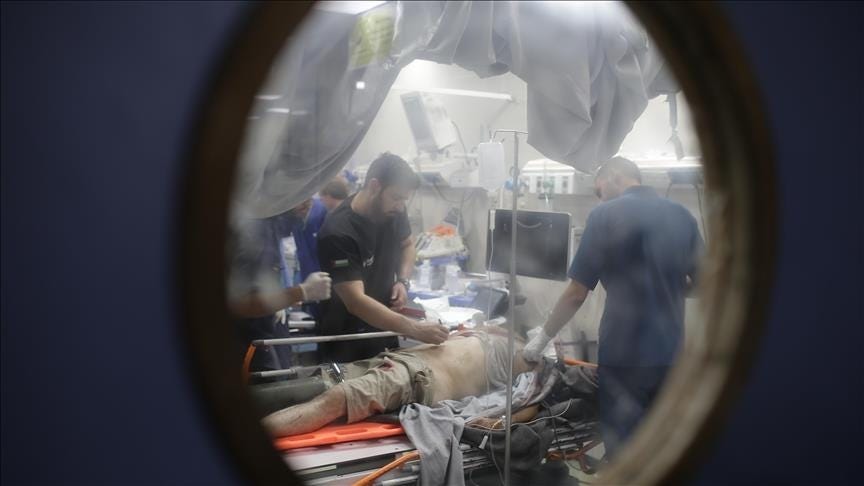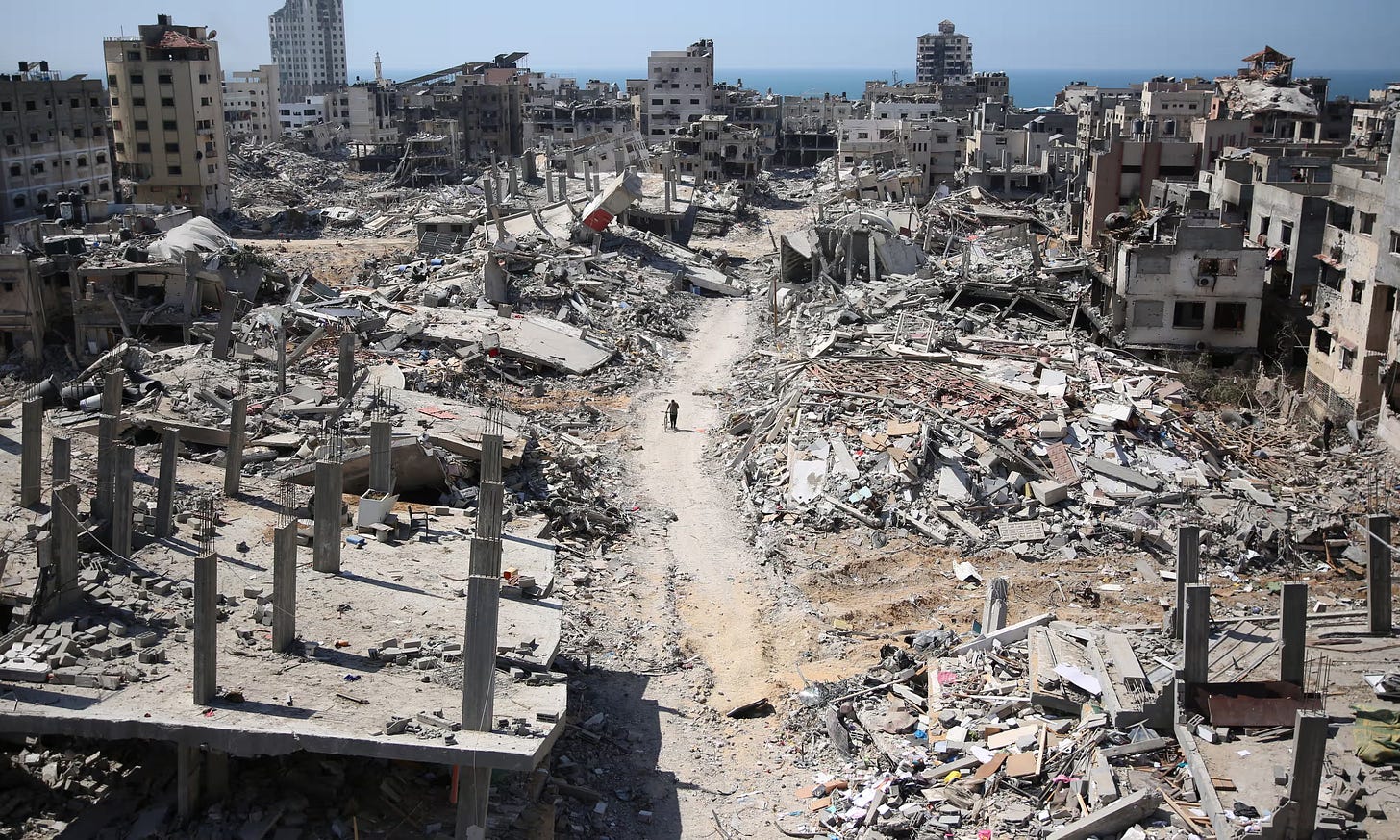"We Are Fighting a Relentless Battle for Survival": An Interview with Gaza Municipality Spokesperson
Since its founding in 1893, the Gaza Municipality has been one of the oldest Palestinian municipal institutions, tasked with managing the affairs of the city and serving its residents through various historical junctures—despite the turbulence of politics, occupation, and successive wars. Over the decades, the municipality has weathered immense challenges, from military incursions and assaults to sieges and crippling resource shortages. Yet no crisis has matched the scale of the catastrophe triggered by Israel’s war on Gaza, which began on October 7, 2023.
Since that date, Gaza City has become a primary target of Israel’s relentless military campaign and suffocating siege. For months, the city has endured unrelenting bombardment and direct strikes, resulting in massive destruction of infrastructure and vital facilities. The humanitarian situation is dire, with the near-total collapse of basic services amid one of the most severe emergencies in Gaza’s modern history.
Still, the Gaza Municipality has persisted in its mission, operating under extraordinary circumstances with severely limited resources, trying to provide a bare minimum of services. This is all taking place as hundreds of thousands of displaced people crowd into residential neighborhoods, exacerbating environmental, health, and financial crises.
In this exclusive interview with NoonPost, Assem Al-Nabeeh, spokesperson for the Gaza Municipality, offers a detailed look at the situation on the ground. He shares figures on the scale of destruction, outlines the daily challenges municipal teams face amid a lack of international support, and discusses emergency response plans, coordination with international institutions, and the prospects for reconstruction.
He also delivers urgent appeals to the international community.
To begin with, how would you describe the state of Gaza’s infrastructure after months of continuous assault? Which sectors have been hit the hardest?
Frankly, Gaza City is suffering from widespread destruction of its infrastructure and critical facilities as a result of the ongoing war.
By the numbers: damage has affected more than 800 kilometers of roads and streets. Over 75% of the municipality's central water wells have been damaged. More than 100,000 linear meters of water networks and 175,000 linear meters of sewage networks have been affected.
All of the city’s sewage pumps and treatment stations have sustained damage to varying degrees, ranging from partial to total destruction. The damage hasn’t been limited to public services; it has also affected cultural centers, the central archive, and public parks.
In practice, we can say that nearly all of the city's municipal infrastructure has been either completely destroyed or partially damaged.
Despite the vast destruction and collapse of service networks, the Gaza Municipality has continued its operations over the past months. How have you managed to maintain daily functions under such extreme conditions?
Despite the intense bombing and the widespread collapse of Gaza's infrastructure, the municipality never ceased its essential duties. Our teams continued their work under fire and in exceptionally complex conditions, operating around the clock to provide basic services, despite severe security risks and minimal resources.
The municipality established four urgent priorities to guide its efforts amid the humanitarian disaster:
Securing water access by reactivating damaged wells and conducting minimal repairs to crippled water networks, despite the fact that over 75% of the city’s wells have been destroyed.
Waste collection and removal from crowded neighborhoods to prevent the spread of disease.
Emergency sewage repairs, given that major damage to treatment stations and pumps poses a direct environmental hazard.
Clearing roads and streets blocked by debris to allow movement and ensure ambulances and civil defense teams can reach affected areas.
All of this is happening while over 85% of the municipality’s heavy and mid-range vehicles and equipment have been destroyed, making every operation a logistical challenge. Despite this, our staff have continued working with extremely limited capabilities, supported in part by community efforts and volunteer coordination, to preserve the minimum necessities of life in this devastated city.
What are the most pressing financial challenges facing the Gaza Municipality today? Have you received any assistance to cover operational or emergency needs?
The financial crisis is among the most severe challenges we face. It didn’t start with the war but has worsened dramatically since the onset of the genocide in late 2023.
The collapse of the economy and the halt of most productive and service activities have led to an almost complete loss of municipal revenue. This has left us unable to meet even the most basic financial obligations.
Since the beginning of the war, municipal employees—including emergency teams who have worked without pause since October 2023—have not received their salaries. They are not granted any of their rights or entitlements, surviving only on small advances that barely meet minimal living expenses, especially amid soaring prices and worsening humanitarian conditions.
While the municipality has received some limited aid in recent months—notably through waste management support projects that helped pay sanitation workers—this assistance is minuscule relative to the scale of the disaster and does not address the core financial crisis.
Currently, the municipality relies almost entirely on emergency aid from humanitarian and development organizations. But these interventions fall far short of covering operational costs or emergency and maintenance projects, leaving us in an extremely difficult position and threatening our ability to continue delivering essential services.
From an environmental perspective, what are the risks stemming from damaged sewage systems and uncollected waste? How are you handling these public health threats given the limited resources?
The city is facing a full-blown environmental and public health disaster. Over 170,000 tons of waste are piled up across Gaza’s streets and neighborhoods because we lack the equipment and fuel to remove it.
In addition, massive amounts of sewage have leaked into streets and residential areas, posing a serious threat. For example, the Sheikh Radwan basin, which was designed to collect only rainwater, has now been heavily contaminated with sewage. It poses a dual threat: flooding of surrounding residential and shelter areas, and contamination of the underground aquifer—currently the only source of water available to residents.
The accumulated waste is also an environmental and health catastrophe, attracting rodents and insects and posing a risk of leachate seeping into the soil, which further threatens the aquifer and increases disease risk.
Since the start of the war, we have been trying to implement emergency interventions to mitigate the disaster. We are working to unblock sections of the sewage system and move limited waste collection vehicles into the most heavily affected areas. But these efforts are insufficient. Over 85% of our heavy and mid-range equipment has been destroyed, and we face acute shortages of fuel, disinfectants, and essential tools.
In short, we are doing everything we can with what little we have. But we urgently need coordinated international assistance to avoid a full-blown health catastrophe—especially as summer approaches and risks multiply if the situation is not addressed promptly.
With tens of thousands of displaced people now crowded into Gaza’s residential neighborhoods, how is the municipality addressing this massive humanitarian and social challenge?
There’s no doubt that the mass displacement of people from northern Gaza into Gaza City has created an unprecedented strain on basic services, which were already critically depleted by the war. For example, only 40% of the city currently receives water, and even that is irregular and limited. As the number of displaced people increases, the pressure on these fragile networks intensifies.
The crowding of tens of thousands of families into central Gaza’s streets and neighborhoods has compounded the crisis, overwhelming both infrastructure and our already exhausted municipal teams. Most of the displaced lack adequate shelter, living in tents or open areas in densely populated districts, heightening health risks.
One particularly dire concern is that a major displacement site lies near an informal waste dump, posing a severe threat of disease outbreaks in the absence of an effective public health system.
We are doing what we can with our remaining personnel—conducting limited clean-up operations near displacement sites and delivering minimal water supplies—but resources are painfully scarce. We urgently need international support to provide safe shelter and bolster vital services that are buckling under the weight of this crisis.
We understand the immense suffering of the displaced, and we are doing our utmost to ease their plight. But the scale of the disaster far exceeds the municipality’s capacity.

Does the municipality have emergency response plans in place to address the current crisis? What kind of coordination exists with local and international organizations?
Yes, the Gaza Municipality has pre-prepared emergency response plans, developed in coordination with most international organizations operating in the sector. These plans identify detailed needs, documented and described with technical precision.
We have submitted comprehensive lists of daily fuel requirements for critical infrastructure, the heavy equipment needed to clear rubble and open roads, as well as maintenance tools and operating materials required to maintain minimal services.
We’ve emphasized to our international partners that these are not luxury items, but basic survival necessities for hundreds of thousands of people.
Before the January ceasefire agreement, we received promises from several international bodies that these needs would be met, and that the entry of equipment and materials would be facilitated. But unfortunately, nothing has materialized. No equipment has arrived. No fuel or maintenance materials have been delivered. We continue operating in unbearable conditions, with dwindling resources and exhausted personnel.
Still, we are actively maintaining coordination with all relevant entities and working to keep these plans updated, in the hope that this coordination will translate into real, tangible support. The situation can no longer endure further delays or empty promises.
Have any international or regional bodies contacted you to discuss reconstruction and rehabilitation plans for Gaza’s infrastructure? Has the municipality been invited to participate in future planning?
We are constantly reaching out to relevant international and regional stakeholders. We have submitted detailed plans and proposals outlining our vision for rebuilding Gaza, including guiding principles and local perspectives on reconstruction.
We’ve shared these documents with numerous international organizations and have expressed our full readiness to play a central role in any future planning processes.
We now await serious engagement from donors and the international community. We insist that any future reconstruction efforts must be aligned with the urgent needs of the people on the ground.

Finally, what messages would you like to convey to the international community and humanitarian organizations, given the collapse of basic services and the growing suffering of Gaza’s residents?
Our message today is the same one we’ve been repeating since the war began—only now it is more urgent than ever: We implore the international community and humanitarian organizations to act swiftly and decisively to deliver the equipment, machinery, and materials Gaza so desperately needs, especially the heavy machinery required for emergency response.
We urgently need this equipment to clear blocked roads, repair water and sewage networks, collect and remove waste, and carry out debris removal, which continues to obstruct movement and exacerbate environmental and health hazards.
We also stress the need to bring in maintenance materials, fuel, and to restore power sources—particularly electricity. Prolonged outages paralyze essential services and worsen the public health and humanitarian crisis.
It has been more than 17 months since the crisis began. Every day of delay deepens the catastrophe. What we need now is real, immediate action—not more deferred promises.





